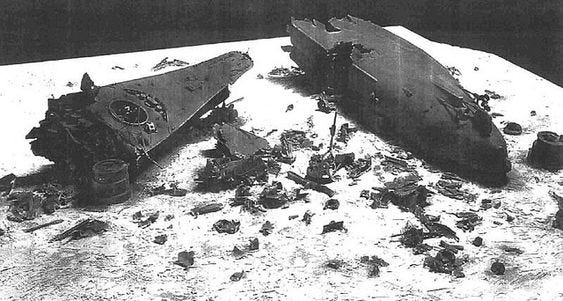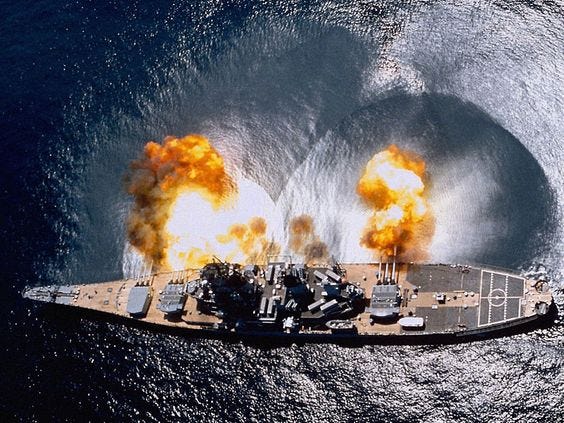So… whenever something pops off in the world, people on museum ship and battleship (anti)social media pages like to ask “when is the Navy going to take the battleships back so that they can go destroy the bad guys?” or some variation thereof…
Well the answer is simple and boring. The Navy isn’t about to take any ships from the museums and put them back into service and there are multiple reasons for this. That is not to say that it is impossible for these ships to be put back into service, but it is improbable that these ships will ever be anything more than museums. What follows is my opinion of the matter…
We judge these ships from the tour routes of them as museums and say “well it looks like it’s in good shape” or we remember the images from WW2 through Desert Storm of these ships firing shells at a enemy positions and think that is just the thing we need to strike fear into the enemy… Yes, they were impressive and did find purpose through out their lives but the truth is that the 6 Iowa’s were obsolete when they were launched and newer tactics and weapon systems can do what those ships could do much more efficiently and more cost effectively.
So here is why I believe that we will never see these ships sailing the seas again.
Crewing would be a major problem
There is no material support for these vessels
No training pipeline to produce new sailors for replacements
Not enough adequate industrial infrastructure to support these vessels
Though impressive, they are obsolete and would be better targets than they would anything else.
First
Crewing the vessels would be complicated. The four completed ships of the Iowa class were returned to service at various points throughout their lives and were somewhat “modernized” but were mostly the same ships as they were in the 1940s. That means that everything that made the ships work was manually operated and even into the 1980’s there was still a large enough number of people with the experience necessary in order to figure out how to operate the ship. The engineering plant of one ship alone required over 400 people to operate and maintain the steam propulsion plant as well as the all of the auxiliary equipment needed to make these ships work, and while there are still some steam powered ships still in the Navy, they are not operated the same as the Iowa class were and much of the equipment that these sailors would have to maintain, repair, and operate is older than some of the grandparents of the people who would theoretically crew these ships. Could the crews figure them out? Sure, everything is figureoutable, but that would require very specific leadership and very unique and talented people who were all committed to the mission of being able to make 80 year old ships operate efficiently, and frankly, I don’t believe the culture of the Navy would allow the kind of free reign needed by the crew in order to make any of that kind of magic happen. The kind of people that make those kinds of things happen don’t care about PT tests and careerism, not that PT and career progression are unimportant, but the kind of people that would be needed to lead the crew would be folks that see things almost completely differently than the majority of leadership. These type of folks care about making things work and taking care of business. That kind of culture may still exist in the Navy but it’s most likely rare and was in severe decline when I was a part of the Navy. This isn’t a dig on the Navy, industry follows the same kind of trend where excellence in your job is a “fluid” definition.
The Navy already has enough problems with trying to get people to join up. Each battleship would require about 2000 men for the crew, so adding a demand for 8000 more people would make the recruitment quota problem even more difficult.
Second
Second is material support. There are no spare parts, ammunition, or powder in the supply system anymore. There is no need to have stores of 16” Mk8 armor piercing shells anymore or the powder to push them out of the end of a gun. All of the systems on these ships were built 80 years ago and require repair parts that don’t exist anymore, at least not in any quantities. Could new parts be made for them? Sure, but making one part for something is incredibly expensive, especially when a part has to be made to work with other stuff may be worn out. In order to alleviate this problem, the Navy could lean more on each ship’s repair division to produce repair parts when capable. Each of the Iowa’s have well equipped machine shops and foundry capability so in theory, they would be able to support themselves in the event that they needed to reproduce repair parts.
The issue with this is that Navy has outsourced so much of its repair capability to civilian companies, civilian government workers, and to contractors that there is a lack of skills needed for the crew to be able to make complicated machine replacement parts and to repair machinery. The trend when I was in the Navy was to outsource the work, which turned the crew essentially into machinery cleaners and operators.
Third
There is no training pipeline for new sailors. Very little is done the same way that it was done in the 1940s and if these ships were to be put back into service, schools would have to be created to train people how to operate these antique systems, which only exist on four ships. Part of what made the WW2 US Navy so powerful was that it operated using American ingenuity and efficiency. A lot of the systems and parts were standardized from class to class but also across the Navy. It’s still that way but the systems and machines are different than they were in the 1940s. For instance, the Mk12 5” 38 caliber gun were everywhere. They were mounted on every ship that could handle the weight of the mount and the mounts supporting systems. A gunners mate or fire control controlman could transfer from a destroyer to a battleship and generally know how to operate the guns. Many systems were the same and so training was standardized for efficiency. Yes there are manuals and notes still in existence which could teach new folks how to operate these ships, generally speaking, but stuff isn’t operated the way the manual explains. Machinery is operated through experience and then once experience, knowledge, and wisdom is gained, it is passed down from one group to the next group. Machines don't operate exactly how the manuals and instructions explain, they operate however it is that they operate and experience is the only way to know how to make a thing do what it is supposed to do. Even within the same class of ship, the systems would have their own operational personality and would require a different touch than the sister ships would require. The manuals and procedures help, but experience is what matters and there is very little if any institutional experience in operating these ships.
Fourth
There is very little industrial infrastructure and support left that can handle vessels of this size. The US Navy is the most dependent of the five branches on industrial infrastructure. Back in WW2, there were several dry docks on all three coasts that could handle ships the size of battleships and now we have far less. We don’t have the specialty shops needed to reline 16” gun barrels or overhaul gyros built in the 1940’s. We don’t have the boiler shops to repair Babcock and Wilcox type M boilers. We don’t have the instrumentation shops that can rebuild and calibrate mechanical fire control computers when they get damaged, but what’s more importanter is that we don’t have the knowledge base to make repairs to these machines and systems. Things just simply aren’t done the same way anymore and we can’t necessarily repair old technology with new technology.
Fiff…
Battleships are impressive. I love Battleships. I have volunteered on one and wish that I could do more to help them. I have read about and learned about battleships ever since I was able to read. I love talking to visitors about the engine room and the ships in general. I would love to be able to be part of the crew of one but… battleships are irrelevant. Yes it is impressive to be able to lob 9 2700lb angry birds at a target 24 miles away and land all of them inside a 100 meter circle. But it would take 2000 people to operate a very inefficient ship in order to deliver those rounds with no guarantee that the shells would do any good, even though the sight of it all would be spectacular… Whereas a 567 foot ship with 400 people could shoot one missile from 1300 miles away and pretty much guarantee a direct hit exactly where the target needs to be hit, while at the same time providing naval gunfire support with a degree of accuracy that battleships could never dream of being capable of. During a gunnery exercise, my ship was able to repeatedly hit a target tank from five miles away.
Battleships needed lots of guns because it took a lot of shells to score a hit. Modern naval guns don’t have that problem. Do they have the power of a 16” projectile? Not even close, but there are other tools available in Uncle Sam’s toolbox that will fill the gap where 16” shells used to be and those tools can be delivered from smaller platforms that can be used for multiple purposes and missions. Yes, missiles are incredibly expensive but when you take into account everything needed to deliver that weapon compared to what it takes for a battleship to deliver its weapons, the accuracy and potency of guided missiles and bombs becomes much more affordable.
People like to talk about the armor protection of these ships and I believe that they would fare pretty well against missile attacks but I’m not sure that would matter and the reason why is… Submarine and torpedos. Modern torpedos are not the same as the WW2 versions that Iowa’s torpedo protection was designed to counter. Modern torpedos don’t impact on the side of the hull, they explode underneath the vessel, creating a giant void under the most critical structural part of the ship; the keel. The shock of the explosion wrecks the integrity of the structure and then the void created by the explosion causes the structure to collapse. At the vary least, that kind of torpedo damage would cause severe damage to the engineering plant which would render the ships useless, much as it would any ship.
But then again… both the IJN Yamato and Musashi were sunk by torpedos and their armor was thicker than the armor installed on the Iowa’s so it probably doesn’t matter where they got hit, if they got hit with enough torpedos.

Conclusion
With all of the above being said, it is entirely possible for these ships to be returned to service. It isn’t an impossibility, but mostly improbable due to what I listed above. I suppose that the argument could be made that the ships could be gutted and all of the old technology discarded and replaced with modern equivalents, but that would be a much more complicated project than appears and it would be easier to design and build a new class of ship that would work better for modern warfare rather than go through all of the effort to turn these vessels into something that they were never intended to be.
It’s fun to think about these four Iowa’s steaming on the seas and firing those massive guns. I like the ships. I’ve always liked the ships. Battleships are some of the most beautiful naval vessels ever built, in my opinion. They stand as a testament to what used to be America’s industrial and military capability and ingenuity but their time of being the rulers of the seas has come and gone and will never be again. We should look to these vessels and honor those who designed, built, and crewed them instead of wishing them to be returned to service in an environment where they face the distinct possibility of being lost forever.
Thanks for reading along. Please subscribe if you haven’t already. Its free to subscribe and you can leave whenever, there is no obligation. Also, please like, share, and comment if you want... or don’t. Again, thanks for reading my musings, I hope you have a blessed day.
Fair Winds and Following Seas,
Nate








I have heard the argument on returning those vessels to service. I have never thought about all it would take to power them much less fight with em. I rebuild a 1956 model truck, the technology used in that is obsolete, I can’t imagine what a vessel of that size and age would take to operate.
Very informative and thought provoking.
Keep it up!!
I think they will live on romantically forever in our hearts, similarly to A-10's. Absolute beast-modes.